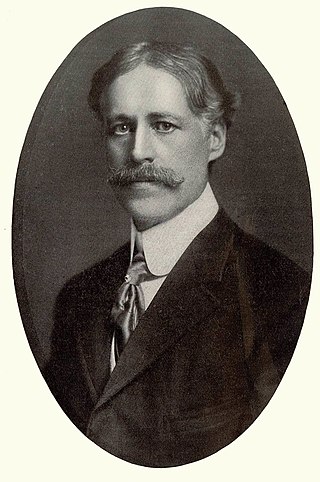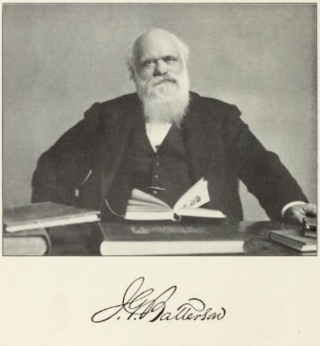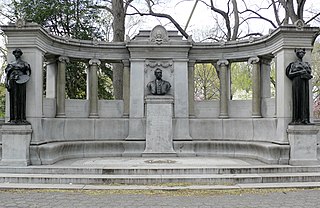
Sleepy Hollow Cemetery in Sleepy Hollow, New York, is the final resting place of numerous famous figures, including Washington Irving, whose 1820 short story "The Legend of Sleepy Hollow" is set in the adjacent burying ground at the Old Dutch Church of Sleepy Hollow. Incorporated in 1849 as Tarrytown Cemetery, the site posthumously honored Irving's request that it change its name to Sleepy Hollow Cemetery. It was listed on the National Register of Historic Places in 2009.

William Ordway Partridge was an American sculptor, teacher and author. Among his best-known works are the Shakespeare Monument in Chicago, the equestrian statue of General Grant in Brooklyn, the Pietà at St. Patrick's Cathedral in Manhattan, and the Pocahontas statue in Jamestown, Virginia.

William Jenkins Worth was an American officer during the War of 1812, the Second Seminole War, and the Mexican–American War.

John Quincy Adams Ward was an American sculptor, whose most familiar work is his larger than life-size standing statue of George Washington on the steps of Federal Hall National Memorial in New York City.

Madison Square is a public square formed by the intersection of Fifth Avenue and Broadway at 23rd Street in the New York City borough of Manhattan. The square was named for Founding Father James Madison, fourth President of the United States. The focus of the square is Madison Square Park, a 6.2-acre (2.5-hectare) public park, which is bounded on the east by Madison Avenue ; on the south by 23rd Street; on the north by 26th Street; and on the west by Fifth Avenue and Broadway as they cross.

James Edward Kelly was an American sculptor and illustrator who specialized in depicting people and events of American wars, particularly the American Civil War.

Worth Square, or General Worth Square, is a public square in Manhattan located at East 25th Street between Broadway and Fifth Avenue directly west of Madison Square Park. The location was designated as a public park in 1847, and since 1857 the square has served as both a memorial to and the burial site of William Jenkins Worth. The only other monument that doubles as a mausoleum is Grants Tomb in Harlem. The 0.27 acre square is one of the many Triangle/Plazas administered by the New York City Department of Parks and Recreation.

James Goodwin Batterson was an American designer and builder, the owner of New England Granite Works from 1845 and a founder in 1863 of Travelers Insurance Company, both in Hartford, Connecticut. He introduced casualty insurance in the United States, for which he was posthumously inducted into the Insurance Hall of Fame (1965).

Major General John A. Logan, also known as the General John A. Logan Monument and Logan Circle Monument, is an equestrian statue in Washington, D.C., that honors politician and Civil War general John A. Logan. The monument is sited in the center of Logan Circle, a traffic circle and public park in the Logan Circle neighborhood. The statue was sculpted by artist Franklin Simmons, whose other prominent works include the Peace Monument and statues in the National Statuary Hall Collection. The architect of the statue base was Richard Morris Hunt, designer of prominent buildings including the Metropolitan Museum of Art in New York City and The Breakers in Newport, Rhode Island. Prominent attendees at the dedication ceremony in 1901 included President William McKinley, members of his cabinet, Senator Chauncey Depew, Senator Shelby Moore Cullom, and General Grenville M. Dodge.

The Richard Morris Hunt Memorial is an exedra of granite and marble, dedicated to the memory of the architect Richard Morris Hunt, designed by Bruce Price with three sculptures by Daniel Chester French, a bust of Hunt, and two flanking statues representing painting and sculpture architecture. The memorial is located at the Central Park perimeter wall, at Fifth Avenue and 70th Street in Manhattan, New York. The bronze sculptures were cast by the Henry-Bonnard Bronze Company of New York.

William Tecumseh Sherman, also known as the Sherman Memorial or Sherman Monument, is a sculpture group honoring William Tecumseh Sherman, created by Augustus Saint-Gaudens and located at Grand Army Plaza in Manhattan, New York. Cast in 1902 and dedicated on May 30, 1903, the gilded-bronze monument consists of an equestrian statue of Sherman and an accompanying statue, Victory, an allegorical female figure of the Greek goddess Nike. The statues are set on a Stony Creek granite pedestal designed by the architect Charles Follen McKim.

Admiral David Glasgow Farragut, also known as the Admiral Farragut Monument, is an outdoor bronze statue of David Farragut by Augustus Saint-Gaudens on a stone sculptural exedra designed by the architect Stanford White, installed in Manhattan's Madison Square, in the U.S. state of New York.

An outdoor granite sculpture of Alexander Hamilton by Carl Conrads is installed in Central Park, Manhattan, New York. Hamilton's son, John C. Hamilton, commissioned Conrads to sculpt this statue, which was dedicated on November 22, 1880, and donated to the city. Conrads used the bust of Hamilton created by the sculptor Giuseppe Ceracchi as a model for Hamilton's head.

An equestrian statue of Simón Bolívar, sometimes called the Simón Bolívar Monument, is installed in Manhattan's Central Park, in the U.S. state of New York. The memorial features a bronze sculpture by Sally James Farnham resting on a black granite pedestal designed by the firm Clarke and Rapuano. It was cast in 1919, dedicated on April 19, 1921, rededicated on April 19, 1951, and conserved by the Adopt-a-Monument Program in 1988.

The Lafayette Memorial is a public memorial located in Brooklyn's Prospect Park in New York City. The memorial, designed by sculptor Daniel Chester French and architect Henry Bacon, was dedicated in 1917 and consists of a bas-relief of Gilbert du Motier, Marquis de Lafayette alongside a groom and a horse.

General Alexander Macomb is a monumental statue in Detroit, Michigan, United States. It was designed by sculptor Adolph Alexander Weinman and was dedicated in 1908 in honor of Alexander Macomb, a Detroit native who had served as the Commanding General of the United States Army for several years in the early 1800s. The monument, which consists of the bronze statue of Macomb standing atop a granite pedestal on a circular concrete platform, was dedicated on September 11, on the anniversary of the Battle of Plattsburgh, a War of 1812 battle that Macomb had participated in. Since the 2010s, the statue has come under criticism due to Macomb's connections to slavery and the mistreatment of Native Americans, with several news sources publishing opinion pieces calling for the statue's removal. During the George Floyd protests in 2020, the monument was vandalized several times.

















